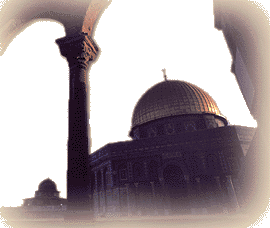| Hashemite Restorations of the Islamic Holy Places in Jerusalem
The Hashemite clan ruled over parts of the Hijaz region of Arabia from 967 CE to 1925 CE in unbroken succession. Moreover, the late King Hussein’s branch of the Hashemite family ruled the holy city of Mecca from 1201 CE until 1925 CE. The history of Hashemite leadership in the Arab and Islamic world finds Jordan's current monarch, King Abdullah bin Al-Hussein, at the head of a family which represents over a thousand years of rule in the region, and with a long history as guardian of the Islamic faith and the holy city of al-Quds al-Sharif (or Jerusalem). |
||||
|
|
In the center of the Old City of Arab East Jerusalem sits a sprawling compound known as al-Haram al-Sharif (The Noble Sanctuary). The compound, which contains two mosques, many shrines and public fountains, as well as the tombs of Muslim saints, is so holy and dear to Muslims that in the advent of Islam the faithful turned towards Jerusalem, and not, as they later did and continue to do so today, towards Mecca. Al-Haram al-Sharif is described as the first qibla (direction to which Muslims turn in prayer), and the third holiest shrine after Mecca and Medina. |
|||
| At the visual center of the area lies the golden Dome of the Rock which was completed in 691 CE by Caliph ‘Abd al-Malik ibn Marwan. The Dome of the Rock was built to commemorate the Prophet Muhammad’s famous night journey (al-Isra’ waal mi’raj). In the year 620 CE he was transported from Mecca to Jerusalem in a mystical flight, and from the rock around which the shrine was later built, he ascended to heaven. Today Muslims celebrate this annually during al-Isra’ waal mi’raj, which this year will be on November 16th. The second mosque in al-Haram al-Sharif, at the end of a walkway connecting it to the Dome of the Rock, is al-Aqsa Mosque, or “The Farthest Mosque.” It is so named in reference to the Qur’anic verse citing Jerusalem as “The far distant place of worship.” Al-Aqsa Mosque was completed in the year 715 CE, and is distinguished by its silver dome, slightly lower in height than the Dome of the Rock. |
||||
